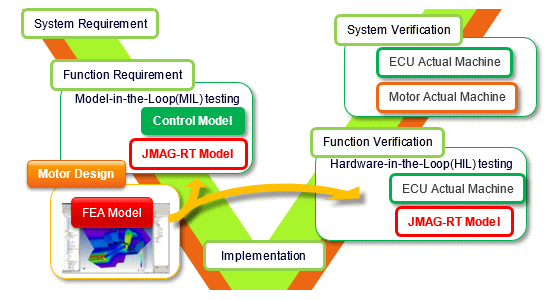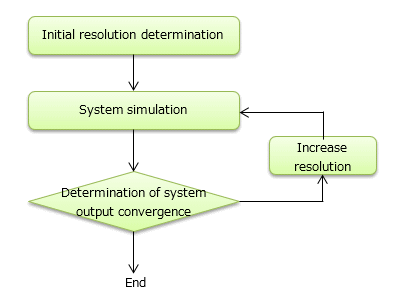Contents
1. Background
2. Determining the Optimum Resolution
3. Case Study
1. Background
In recent years, with the shortening of the development cycle, the application of model-based development (below, MBD) is progressing. Highly accurate plant models are important elements in MBD applications, and JMAG-RT generates highly accurate plant models from FEA models (Fig. 1). The accuracy of the plant model depends on the number of calculation points by FEA. As the number of calculation points increases, the resolution of the model improves, but the time for generation becomes longer. An optimal resolution for determining the number of calculation points is necessary, not only because excessive resolution requires increased time for generation, but also the data size has a significant impact on HILS.
In this paper, we present a method to increase the resolution of a JMAG-RT model iteratively while performing system simulation.
 Fig. 1 Process for V model development using JMAG-RT
Fig. 1 Process for V model development using JMAG-RT
MBD is encouraged by generating highly accurate plant models from FEA models.
For this purpose, accuracy comparable to an actual machine is required, and sufficient resolution of motor characteristics is required.
2. Determining the Optimum Resolution
For this method, the resolution of the plant model is iteratively increased. During this process, computation accuracy (system output) in the operating range is evaluated and the resolution is increased as necessary. The important point here is to minimize the number of iterations, for which deciding the appropriate initial resolution is required. Appropriate resolution is dependent on the motor, but in many cases the usual basic motor characteristics are often ascertained beforehand by electromagnetic field analysis performed at design time. Using this information, the initial resolution is set.
Since MBD does not use an actual machine, the accuracy of the plant model cannot be compared and evaluated with an actual machine. Because of this, while iterating, model is evaluated using the plant model resolution system simulation output (system output) sensitivity. For example, if average torque is evaluated, system simulation is carried out using plant models with different resolutions, from which the variations in average torque are evaluated. Figure 2 shows the flow for determining the appropriate resolution of the plant model.
- The initial resolution is determined.
Using JMAG-RT a JMAG-RT model is generated. - System simulation is performed using the JMAG-RT model generated in step 1.
- If the percent change of the system output from the previous iteration is within the convergence criterion, the iteration ends.
If the percent change with the previous iteration does not satisfy the convergence criterion, the number of calculation points in the JMAG-RT table is increased, and the process returns to step 2.
In this document, the convergence criterion shall be within a 1% variation.
 Fig. 2 Flow of determining resolution
Fig. 2 Flow of determining resolution
Resolution is increased by repeating system simulations.
In order to minimize the number of iterations, it is necessary to set an appropriate initial resolution.
You need to sign in as a Regular JMAG Software User (paid user) or JMAG WEB MEMBER (free membership).
By registering as a JMAG WEB MEMBER, you can browse technical materials and other member-only contents for free.
If you are not registered, click the “Create an Account” button.
Create an Account Sign in



